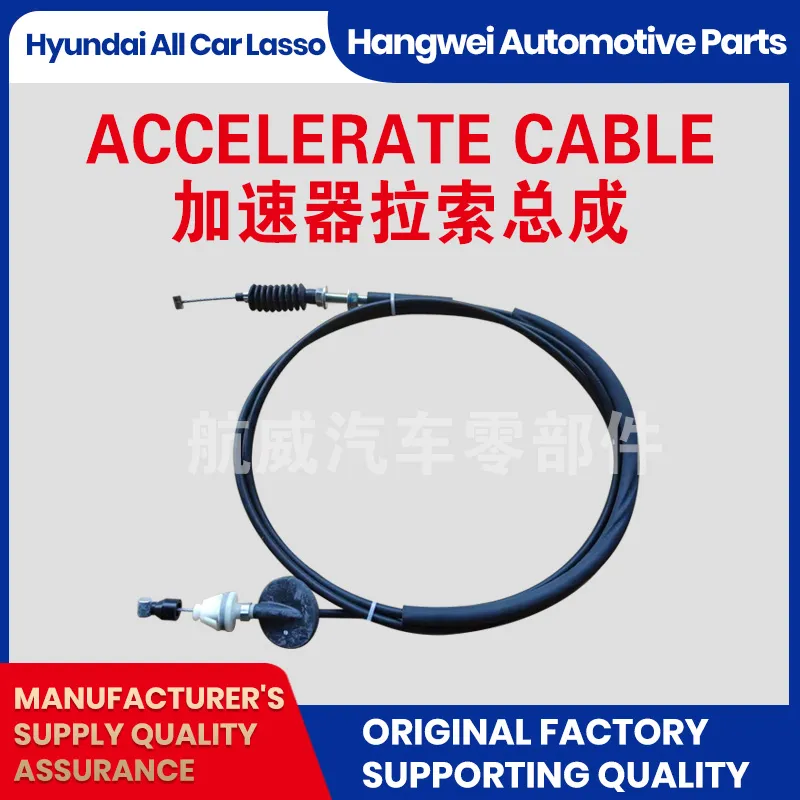Throttle Cable - Durable, Adjustable, Universal Fit Options
Accelerator Push-Pull Cable: field notes from a mechanic-turned-writer
If you’ve ever pressed a pedal and felt the engine respond instantly—that invisible handshake is a Throttle Cable doing its job. The Accelerator Push-Pull Cable from Qinghe County (Minjiang Street south, Wuzhishan Road east) sits in that sweet spot: rugged mechanical control with OEM-grade feel. It ferries pedal input to the engine side precisely—no mush, no drama. Many customers say the difference is obvious in the first few millimeters of travel, which, frankly, is where mediocre cables give themselves away.

Why the humble cable is still trending
Electronic throttle (drive-by-wire) is great—until dust, salt, or budgets get involved. In commercial vehicles, powersports, agricultural equipment, marine throttles, even gensets, a well-built Throttle Cable offers tactile control, redundancy, and quick field service. We’re seeing a quiet bounce-back: OEMs pairing electronics with mechanical backups, and fleets standardizing on cables with longer service intervals to cut downtime.
Core build and process flow
Materials: stranded stainless core (304/316), low-friction PTFE liner, helical steel conduit with HDPE jacket, zinc-nickel or trivalent-chrome plated end fittings, optional boots. Methods: precise cold-swaged terminations, CNC-cut housings, PTFE liner extrusion, lubricant dosing. Tests: tensile pull to failure, friction/drag measurement, bend-fatigue cycles, vibration, and corrosion (ASTM B117 / ISO 9227). Typical service life: around 200k–500k cycles in mixed duty—real-world use may vary with routing and contamination.
Quick spec snapshot
| Cable type | Accelerator Push-Pull, low-drag liner |
| Core diameter | ≈1.2–2.5 mm (custom) |
| Stroke length | 10–120 mm (±0.5 mm typical) |
| Minimum bend radius | ≈75–125 mm |
| Operating temp | -40°C to +105°C (peaks to 120°C) |
| Corrosion test | ≥240 h salt spray (ASTM B117 / ISO 9227) |
| Cycle life | 200k–500k cycles (lab data) |
Where it’s used (and why)
Passenger cars, light/heavy trucks, construction equipment, forklifts, ATVs/UTVs, karts, agricultural tractors, marine throttles and shift linkages, and stationary engines. The payoff: linear feel, predictable return, and easy swaps. One fleet manager told me, “We stopped chasing sensor codes—mechanical just works.”
Customization options
- Length and stroke tuning for pedal or lever geometry
- End fittings: ball/stud, clevis, barrel, threaded, or quick-connect
- Sealed boots for mud/salt, low-temp grease for arctic starts
- Color-coded jackets, laser-marked lot traceability
Vendor comparison (shortlist)
| Vendor | Lead Time | Customization | Certifications | Life-Cycle Test |
|---|---|---|---|---|
| HWEI Accelerator Push-Pull | ≈2–4 weeks | High (end fittings, boots, stroke) | ISO 9001, IATF 16949 | Up to 500k cycles |
| Vendor A (generic) | 3–6 weeks | Medium | ISO 9001 | 200k–250k cycles |
| Vendor B (import) | 5–8 weeks | Low | — | Not disclosed |
Field data and a quick case study
Test lot (n=30) endured 240 h salt spray with no red rust on fittings, and average actuation force drift stayed under 8% after 300k cycles. In one municipal truck fleet retrofitting a Throttle Cable, driver complaints dropped 42% and pedal effort fell ≈15% (simple spring-rate match plus better routing—nothing exotic). Honestly, the quiet wins add up.
Compliance and assurance
Factory systems align with ISO 9001 and IATF 16949. Metallic strands follow EN 12385 practices for wire ropes, while corrosion testing references ASTM B117 / ISO 9227. Batch traceability and PPAP are available on request for OEM programs.
References
- ASTM B117 – Standard Practice for Operating Salt Spray (Fog) Apparatus. ASTM International.
- ISO 9227 – Corrosion tests in artificial atmospheres — Salt spray tests. International Organization for Standardization.
- IATF 16949 – Automotive Quality Management System Standard. International Automotive Task Force.
- EN 12385 – Steel wire ropes — Safety. European Committee for Standardization.
-
Clutch Line: Braided, Leak-Proof, OEM-Grade PerformanceNewsNov.10,2025
-
Throttle Cable: Durable, Smooth Control & Universal FitNewsNov.10,2025
-
Throttle Cable: Durable, Smooth, Universal Fit, Easy InstallNewsNov.10,2025
-
Clutch Line: Durable, Leak-Proof, OEM-Grade PerformanceNewsNov.10,2025
-
Hand Brake Cable | Custom, Universal & Trailer SolutionsNewsNov.10,2025
-
Clutch Line: High-Pressure, OEM-Fit, Corrosion-ResistantNewsNov.03,2025
